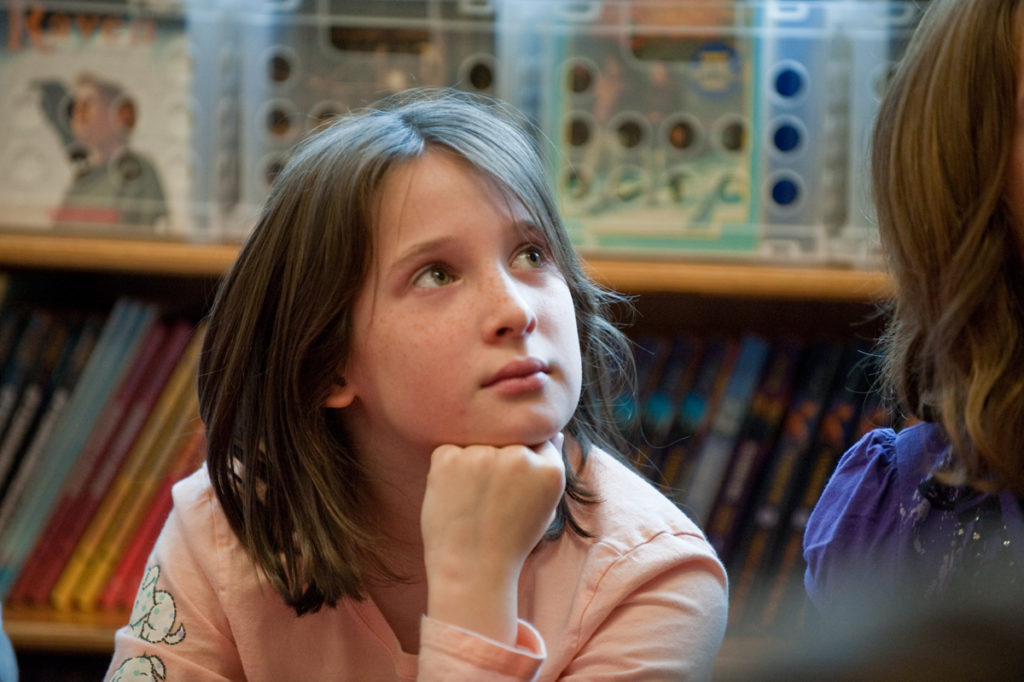Naming What Children Can Do

 Mr. Park’s fourth grade class was the most impulsive and squirmy group of children he’d ever taught. Children speaking out of turn, talking to neighbors, playing with small objects, or making odd noises continually interrupted class discussions. Despite much time spent devising and discussing rules for group meeting behavior, the children made little progress.
Mr. Park’s fourth grade class was the most impulsive and squirmy group of children he’d ever taught. Children speaking out of turn, talking to neighbors, playing with small objects, or making odd noises continually interrupted class discussions. Despite much time spent devising and discussing rules for group meeting behavior, the children made little progress.
Mr. Park decided to try a different approach. During a typically unfocused session, he stopped the discussion and remarked, “You know, I’ve noticed several children sitting calmly and listening when others speak, and we’re hearing good ideas from lots of people. What other things have you noticed going well in this discussion?”
The children sat up a little straighter and leaned forward in interest. “Lots of kids are raising their hands and not calling out,” one student shared.
“I didn’t fool around with my erasers. I just sat here,” Mark announced.
“I noticed a couple of you even sat on your hands for a bit,” Mr. Park observed. “That’s one way to keep your hands empty so you can concentrate. What else could you do to make our discussion even more focused and productive?”
With this positive scaffolding, Mr. Park found the children quite willing to share ideas about what they could do better. “Let’s try it,” he said after they’d made several suggestions. The group’s subsequent round of discussion was not perfect, but it was better. And the children were encouraged and invested rather than discouraged or resistant.
The Power of Reinforcing Language
Teachers have always known the power of carefully timed and delivered feedback. But now growing research evidence points to the impact this feedback can have on children’s learning. However, not all feedback is created equal: Some types are far more potent and productive than others. As the teacher in the example above knew, reinforcing feedback, the kind that gives students specific, positive, and clear messages about their growth and efforts, can transform the way children view themselves and have a powerful impact on their learning.
Known as “reinforcing language” in the Responsive Classroom approach to teaching, this type of specific, positive feedback is powerful, because when used well, it achieves the following:
- Provides children with a positive vision of themselves as learners, thereby promoting engagement in the process of learning. Children rightfully feel proud and competent when we remind them, “A few weeks ago our list of Spanish sight words was one page long, and now we have three charts full!” Pointing out how children’s current behavior compares with less-skilled earlier behavior is an important way to scaffold growth and promote investment in the process of learning. It reminds students that learning is an ongoing and dynamic process, not simply an end product.
- Encourages children to focus on their strengths rather than their deficits, thus nurturing a sense of agency and a growth mindset. To a student who always finds great information for research projects but struggles to write up her results neatly and completely, a teacher says, “You used some really inventive strategies to find out about that rare insect—like searching on the National Geographic website. Let’s plan together how you’ll do your write-up to really showcase what you’ve learned.” This teacher knows that children build on their strengths and can do so more easily when we help them see those strengths.
- Invites children to reflect on their actions and learning, which encourages ownership and self-motivation. Reinforcing feedback, delivered using a focused question, helps children reflect on their actions and learning processes and name for themselves what they’re doing well. Some examples: “What strategy did you use to help you read this passage?” “Yesterday it took eight minutes for everyone to settle down with a book after recess. Today it took only five. What do you think accounted for the difference?” “I noticed people giving helpful clues. What else did you notice people doing that made this activity go well?”
Making It Work
Reinforcing language is most effective in the classroom when it has the following characteristics.
Names Concrete and Specific Behaviors
Rather than giving general praise such as “Good job!” or a description of abstract qualities such as “Beautiful drawing!”, effective reinforcing language provides concrete information about aspects of students’ behaviors, processes, or products that are working well.
For instance, a teacher observing that a student is learning to apply an important spelling rule might say, “You remembered to change the ‘y’ to ‘i’ when adding ‘ed.’ That helped you spell several more words correctly on this week’s quiz.”
Identifying and describing such behaviors helps children become more aware of what they know and can do and how they’ve progressed. With that awareness, children have greater access to and control over the behaviors that lead to optimal growth and learning.
General praise such as “Good job!” or “Beautiful work!” can be appropriate and effective at times. It all depends on your purpose. If you want to celebrate with children, use general praise. But if you want to instruct or foster change and growth, reinforcing language works better.
Points Out Approximations Toward Mastery
Even when children’s behavior or work isn’t completely successful, careful observation will reveal positive aspects and growth that you can point out with reinforcing language. For example, Ms. Cortez is discouraged because only a few children shared ideas in a class discussion. But she reminds herself that several children are speaking. And as she observes more closely, she sees that many students are paying attention, even if they’re not speaking.
She points out these positive steps. “Some of you shared your thoughts today and many of you listened respectfully. What else did you do that helped us have a good discussion?” she asks. One child says he thought of ideas although he didn’t say them out loud. Another says classmates’ ideas helped her understand more about the topic.
“We’re well on our way to having some really interesting discussions,” Ms. Cortez continues. “What can we do to make them even better?” Responding to her encouraging tone, the children readily offer ideas. “More people could say their ideas out loud,” one says. Another notes that everyone could really listen to each other and not “space out.”
By sharing observations about where and how children are doing well, we build scaffolds for increased mastery over time. We also help children realize that change and learning are processes, and we guide them toward appreciating progress as well as final achievements.
Emphasizes Description Over Personal Approval
Reinforcing language works best when teachers de-emphasize personal approval and focus instead on giving clear information about what children are doing well. For example, instead of “I loved how you put the oil pastels away so carefully,” try “You really handled the oil pastels carefully so they wouldn’t break when you put them away.”
Focusing on our feelings about children’s efforts implies that the purpose of their actions is to please us and undermines children’s sense of self-control and intrinsic motivation. If, instead, we focus on children’s actions, we send the clear message that they are in charge of their learning and that the benefits are for their own growth and development.
Can we convey warmth and genuine appreciation if we don’t say we love a student’s work or behavior? Absolutely. Emphasizing description over teacher approval does not mean pretending to have no feelings about the behaviors we reinforce. When we describe behaviors we genuinely value, those important for children’s growth and success, our warmth and caring naturally come through in our tone of voice and body language.
Reflects Important Goals and Values
Should teachers mention every positive behavior, no matter how small? No. Instead of showering children with any descriptive feedback you can think of, describe only those positive behaviors that truly matter to the child’s growth and the group’s shared goals.
For instance, if using pencils appropriately is an important goal and a child independently chooses a pencil for a “pencil task” rather than her preferred marker, then feedback about pencil use is meaningful and reinforcing: “I see that you chose to use a pencil for your math practice today. That will let you change answers easily if you need to, so you’ll help our class save paper.” If a child usually uses pencils appropriately, commenting on pencil use may be descriptive, but it’s neither meaningful nor reinforcing.
An Underutilized Tool
Reinforcing language is one of the most powerful tools available to educators—and one of the most underutilized. This language helps students reach toward higher levels of achievement, or what educator Peter Johnston calls the “leading edge”—the place at which a student reaches a bit beyond what she already knows or can do. Using specific reinforcing language to effectively point out children’s successes at their leading edge can be just what’s needed to nudge them toward higher levels of mastery and success. Try it and watch learning light up in your classroom.
Ready to Start Using Teacher Language More Effectively?
Here are some strategies to help you begin:
- Explore examples of specific, informative reinforcing language.
- Watch and listen to teachers using reinforcing language on the Responsive Classroom YouTube channel or the Teacher Language in a Responsive Classroom DVD.
- Think about times of the day when you could use reinforcing language. Make notes in your plan book about words and phrases you could use or put phrases and words on index cards that you can refer to.
- Record yourself for a portion of a day (audio or video); play back the recording to become more sensitive to your language and changes in your language.
